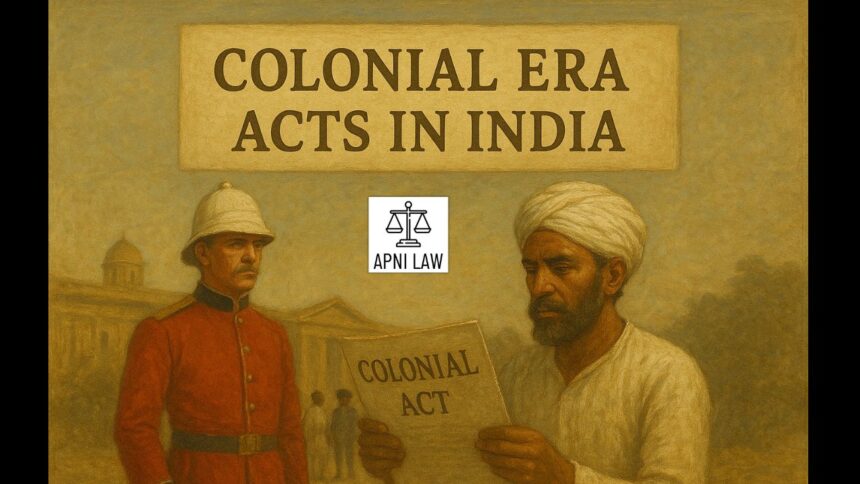Introduction
The Indian Councils Act of 1892 marked a small yet significant step in India’s constitutional journey under British rule. While it did not bring about sweeping changes, it reflected the growing pressure of Indian political awareness and the demands of leaders who sought a role in governance. The Act introduced the idea of indirect representation of Indians in legislative councils, even though their powers remained extremely limited. To understand its importance, one must look at the historical context, its provisions, and its impact on India’s evolving struggle for self-government.
Background to the Act
By the late 19th century, India was experiencing the rise of organized political movements. The foundation of the Indian National Congress in 1885 provided a platform for moderate leaders like Dadabhai Naoroji, Gopal Krishna Gokhale, and Surendranath Banerjee. These leaders demanded more participation of Indians in legislative affairs. At the same time, Britain faced increasing criticism for governing such a vast colony without granting its people any real say in administration.
The earlier Indian Councils Act of 1861 had allowed the inclusion of a few Indians in legislative councils, but they were hand-picked nominees with no actual powers. By 1892, Indian leaders wanted more than symbolic presence. Their persistent petitions, speeches, and resolutions pushed the British government to consider reforms. The result was the Indian Councils Act of 1892, which aimed to address these concerns while still maintaining British dominance.
Key Provisions of the Indian Councils Act 1892
The Act did not grant popular elections, but it introduced an indirect system of representation. Members of provincial councils and local bodies could recommend candidates, who would then be nominated by the Governor or Viceroy. This created the impression of elections, although real authority remained with the colonial administration.
The size of the legislative councils was also expanded. In the Viceroy’s Legislative Council, the number of additional members increased from 12 to 16. In provincial councils such as Bengal, Madras, Bombay, and the North-Western Provinces, the number of members was also enlarged.
For the first time, Indian members could discuss the annual budget, though they could not vote on it. They could also ask questions on matters of public interest, but with restrictions. Supplementary questions or follow-ups were not allowed. Thus, the scope of participation remained narrow and controlled.
In short, the Act offered a limited role for Indians in legislation, but it marked the beginning of budgetary discussions and indirect representation, developments that would later expand into more meaningful reforms.
Role of Indian Leaders and the National Congress
The Indian National Congress had been steadily increasing its influence since its establishment. Leaders submitted memoranda to the British Parliament, highlighting the lack of representation in Indian governance. They argued that Indians, who paid taxes and contributed to the economy, deserved a voice in framing policies.
Dadabhai Naoroji, known as the “Grand Old Man of India,” emphasized the concept of the “drain of wealth” and argued that without Indian participation in governance, exploitation would continue unchecked. Similarly, leaders like Surendranath Banerjee and Gopal Krishna Gokhale urged constitutional reforms and used the Congress platform to mobilize public opinion.
Although the 1892 Act fell short of their demands, it validated the role of political pressure. It proved that consistent advocacy and unity could force the colonial rulers to make concessions, however small.
Limitations of the Act
Despite being portrayed as a reform, the Indian Councils Act of 1892 suffered from severe limitations. The indirect representation mechanism was a compromise, designed to give the illusion of participation without real empowerment. Indians could enter councils but had no control over decisions.
Budget discussions were symbolic, as members could not vote or demand changes. Questions asked in the councils were restricted, and the executive was not bound to act upon them. Moreover, the Governor and Viceroy retained overriding powers, ensuring that ultimate authority stayed with the British Crown.
Thus, while the Act expanded councils and introduced budget discussions, it did not alter the balance of power. Indians remained largely powerless, and the British continued to dictate terms.
Impact of the Indian Councils Act 1892
The Act’s most important contribution was psychological rather than political. It gave Indian leaders a platform to express their opinions, however limited, and to highlight issues affecting their communities. It marked the first step towards representative institutions in colonial India.
This Act also set the stage for the next wave of reforms. Leaders realized that the British would only concede minimal changes unless pressed further. The limited representation made Indians more determined to fight for broader rights. This growing frustration with half-hearted reforms fueled nationalist sentiment, which later found expression in the demand for swaraj, or self-rule.
The Act also trained Indian leaders in legislative practices. Many future nationalist leaders who became prominent in the freedom struggle first gained experience in these councils. By learning how to question, debate, and highlight grievances, they sharpened their political strategies.
FAQ Section
Why was the Indian Councils Act of 1892 introduced?
The Act was introduced to respond to demands by Indian leaders for greater participation in governance. It aimed to expand legislative councils and allow limited representation, though without granting real power.
Did the Indian Councils Act of 1892 allow elections?
The Act did not introduce direct elections. Instead, it created a system where local bodies and provincial councils could recommend candidates, who were then nominated by the Governor or Viceroy. This system gave the appearance of elections without actual democratic choice.
What was the biggest limitation of the Act?
The biggest limitation was the lack of real authority. Indians could discuss the budget but not vote on it. They could ask questions but not follow them up. Final decision-making power remained with the British authorities, making Indian participation largely symbolic.
Conclusion
The Indian Councils Act of 1892 was a modest attempt at reform, but it represented an important stage in India’s constitutional development. For the first time, Indians were allowed to indirectly enter legislative councils, discuss budgets, and raise questions, even though their powers were minimal. The Act highlighted the growing strength of Indian political consciousness and the determination of leaders to push for reform.
Though limited in scope, the Act planted the seeds of representative governance in India. It exposed the unwillingness of the colonial rulers to share real power and intensified the demand for deeper reforms. Ultimately, it was a stepping stone that prepared India for larger constitutional battles in the 20th century, leading eventually to self-government and independence.
For any specific query call at +91 – 8569843472








